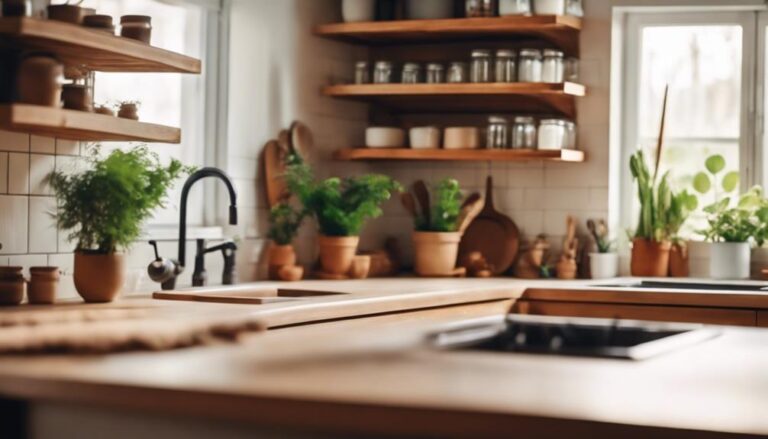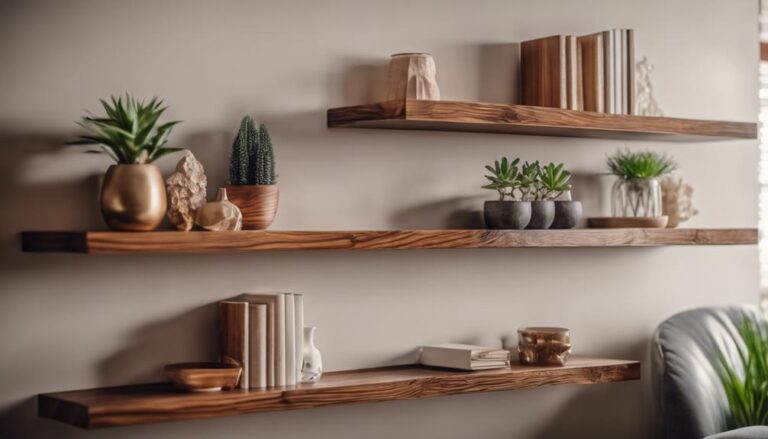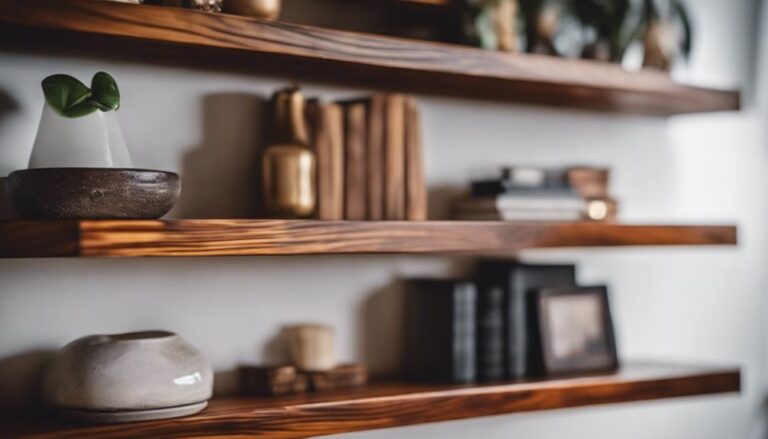Water-Based Wood Finish Options for Floating Wood Shelves: A Comprehensive Guide
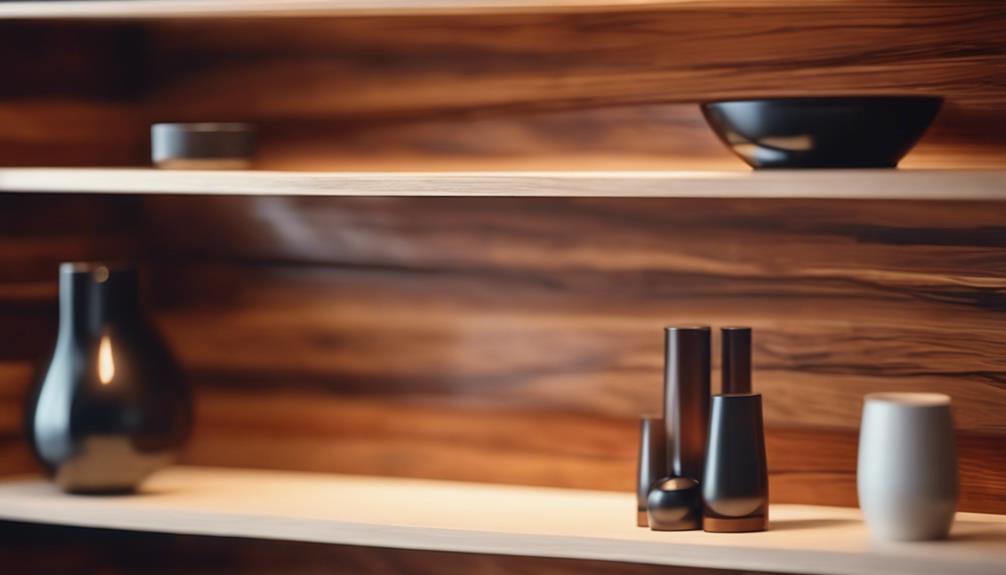
When choosing water-based finishes for floating wood shelves, consider polyurethane, acrylic, and varnish for their specific advantages. Each type offers durability and protection against scratches and moisture.
Before applying a finish, make sure to prepare the shelves thoroughly by sanding and cleaning them. Apply the finish evenly using the correct tools and protective equipment. Follow the manufacturer's instructions for drying and curing times for optimal results.
Water-based finishes are environmentally friendly, reducing VOC emissions and supporting sustainability. Various color and sheen options are available for a personalized touch.
Explore our detailed recommendations for more information.
Key Takeaways
- Types of Water-Based Finishes: Water-based finishes like polyurethane, acrylic, and varnish offer distinct advantages for different floating wood shelf materials, ensuring a tailored finish for your specific needs.
- Preparation and Application: Prior to applying the finish, it is crucial to adequately prepare the floating wood shelves by sanding them smooth and clean. Apply the water-based finish evenly to achieve a professional and polished look.
- Drying Times and Curing: To guarantee optimal results, adhere strictly to the guidelines provided by the manufacturer regarding drying and curing times for the water-based finish on your floating wood shelves.
- Durability and Protection: Opt for water-based finishes known for their durability to enhance the scratch and moisture resistance of your floating wood shelves, ensuring their longevity and functionality.
- Environmental Impact: Water-based finishes are environmentally friendly, reducing volatile organic compound (VOC) emissions and promoting sustainable woodworking practices when applied to floating wood shelves.
Types of Water-Based Finishes
When picking the ideal finish for your floating wood shelves, you'll discover that water-based choices like polyurethane, acrylic, and varnish each bring specific advantages. Let's explore what sets these finishes apart and why they could be the perfect fit for your innovative shelving project.
Polyurethane, a water-based wood finish, offers a transparent, protective layer that highlights the natural beauty of the wood. Renowned for its toughness, polyurethane is a superb option for shelves meant to support heavy items. Not only does the clear coat enhance the visual appeal, but it also provides significant defense against everyday wear and tear.
Acrylic finishes present another excellent option, particularly for indoor projects like floating shelves. They dry rapidly and emit minimal odor, making the application process more convenient and pleasant. With their exceptional durability, acrylic finishes ensure your shelves maintain their charm and resilience over time.
Lastly, water-based varnishes are well-suited for high-traffic areas due to their exceptional resistance to scratches and stains. This makes varnish a robust choice capable of withstanding daily use while retaining a sleek appearance.
Each water-based finish—polyurethane, acrylic, and varnish—brings unique benefits, catering to various requirements and preferences for your floating wood shelves.
Preparing Your Shelves
To get our floating wood shelves ready for the amazing water-based finishes, we must first ensure they're properly prepped. This step is crucial in achieving a professional and long-lasting finish that truly enhances the natural beauty of the wood.
We kick off by sanding the shelves with fine-grit sandpaper, creating a smooth surface that acts as the perfect canvas for the finish to adhere to. Once we've achieved a silky smooth finish, it's imperative to give the shelves a thorough cleaning. Any remaining dust, dirt, or grease can negatively impact the finish application process.
Consider incorporating a wood conditioner into the preparation process. This product helps seal the wood, allowing for uniform absorption of the finish, which is particularly beneficial for softer woods and porous hardwoods.
Furthermore, applying a clear wood sealer can also be advantageous. This step prevents the wood from soaking up too much finish, ensuring a consistent color and boosting the final look's durability.
In summary, here's a quick checklist to steer us through the preparation process:
- Sand with fine-grit sandpaper for a smooth surface.
- Clean thoroughly to remove dust, dirt, and grease.
- Use a wood conditioner for even absorption.
- Apply a clear wood sealer to ensure a uniform color.
Application Techniques
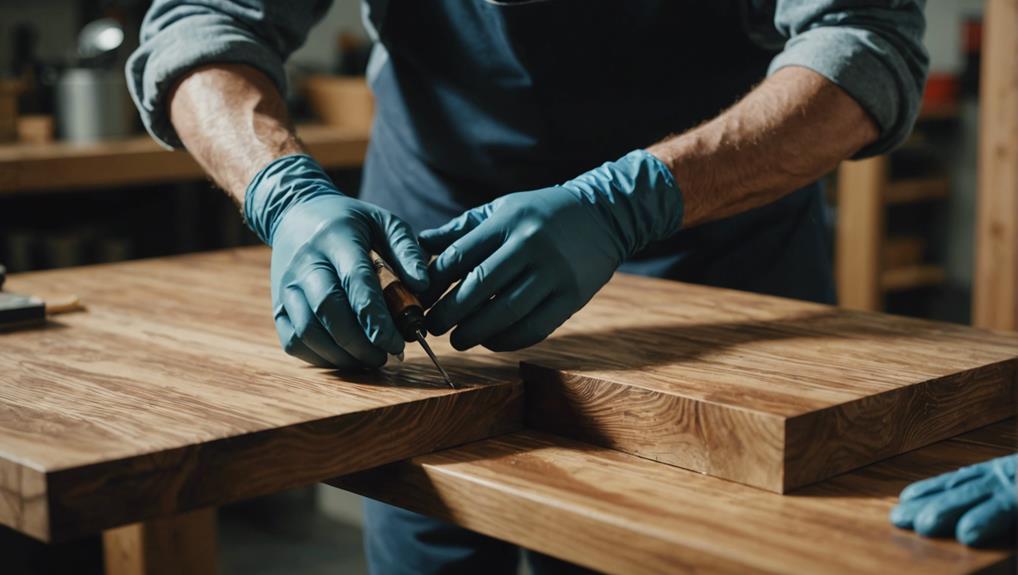
When it comes to applying water-based finishes to our floating wood shelves, attention to detail and the right techniques are key. Proper surface preparation is crucial for a successful finish. Before sanding, dampening the wood surface can help minimize grain-raising and ensure a smoother outcome.
During the application process, it's important to be mindful of how water-based finishes behave differently from oil-based ones. They tend to gel quickly, so it's best to avoid overworking the finish to maintain its integrity.
Timing is also a critical factor to consider. Water-based finishes dry faster in warm, dry conditions and slower in cool, humid environments. Understanding these variables can help us achieve a flawless finish. To streamline the process, here's a quick reference table:
| Step | Action | Tips |
|---|---|---|
| Surface Preparation | Dampen and sand the wood surface | Reduces grain-raising |
| First Application | Apply water-based finish evenly | Avoid overworking |
| Drying Conditions | Ensure warm, dry environment | Speeds up application time |
| Flatness Check | Inspect for initial differences | Adjust as necessary |
Drying Times
When it comes to drying times for water-based wood finishes on floating wood shelves, it's essential to consider both the initial drying period and the full cure time. Typically, these finishes can dry within 1-2 hours, but variables such as temperature and humidity may impact this process.
Following the manufacturer's guidelines is crucial to ensure optimal results and prevent any premature damage to your floating wood shelves.
Initial Drying Duration
Water-based finishes for floating wood shelves typically dry within 30 minutes to 1 hour, which is faster than oil-based options. This quick drying phase allows us to progress with our projects efficiently, but it's essential to consider the factors influencing this process.
Several variables in the drying area can impact the initial drying time of water-based finishes:
- Temperature: Warmer conditions accelerate drying times.
- Humidity levels: Lower humidity speeds up drying, while high humidity can delay it.
- Airflow: Proper ventilation aids in moisture evaporation.
- Thickness of application: Thinner coats dry more quickly than thicker ones.
Creating favorable drying conditions is crucial. Adhering to the manufacturer's guidelines is key to achieving the best results. While it may be tempting to rush, allowing ample time between coats ensures proper adhesion and a durable finish.
Although these finishes dry quickly to the touch, they may require a longer curing time before the shelves can withstand heavy use. Patience and attention to detail are essential for achieving the innovative, high-quality results we strive for.
Full Cure Time
To ensure our floating wood shelves have a fully hardened and durable finish, it's essential to allow them to cure for 7 to 30 days. This timeframe guarantees that the water-based wood finishes fully set, providing optimal protection and longevity. It may be tempting to rush the process, but patience is key. Hastening the curing process can result in a less resilient finish, making the shelves more susceptible to scratches, dents, and other forms of damage.
Understanding the drying time is crucial. Factors such as temperature, humidity, and airflow play a significant role in how quickly the finish dries. It's important to closely adhere to the manufacturer's guidelines to achieve the best outcomes. These guidelines are crafted to assist us in navigating the intricacies of water-based finishes, ensuring that our shelves not only look exquisite but also endure daily use and wear.
Respecting the full cure time isn't just about following instructions; it's about attaining the highest quality finish for those dedicated to innovation and excellence.
Environmental Impact Factors
Understanding the curing process naturally leads us to explore the environmental impact factors associated with drying times. Opting for water-based wood finishes, renowned for their speedy drying times, emerges as a sustainable choice compared to oil-based alternatives. These brief drying periods not only offer convenience but also play a pivotal role in reducing volatile organic compound (VOC) emissions, a crucial consideration for environmentally conscious individuals.
The advantages extend beyond mere convenience:
- Decreased VOC Emissions: The swift drying times translate to lower emissions of volatile organic compounds, contributing to a cleaner atmosphere.
- Improved Indoor Air Quality: By reducing VOC emissions, water-based finishes help enhance indoor air quality, creating healthier living environments.
- Efficient Application: Quick drying enables a smoother and more efficient finishing process, saving both time and resources.
- Sustainability: The rapid curing properties of water-based finishes lessen the environmental impact, aligning with sustainable principles.
For those dedicated to innovation and sustainability, selecting water-based finishes proves to be a commendable decision. These options not only foster a healthier environment but also support streamlined and eco-friendly wood finishing practices. By opting for these finishes, we can significantly reduce our impact on indoor air quality and promote overall environmental sustainability.
Durability and Protection
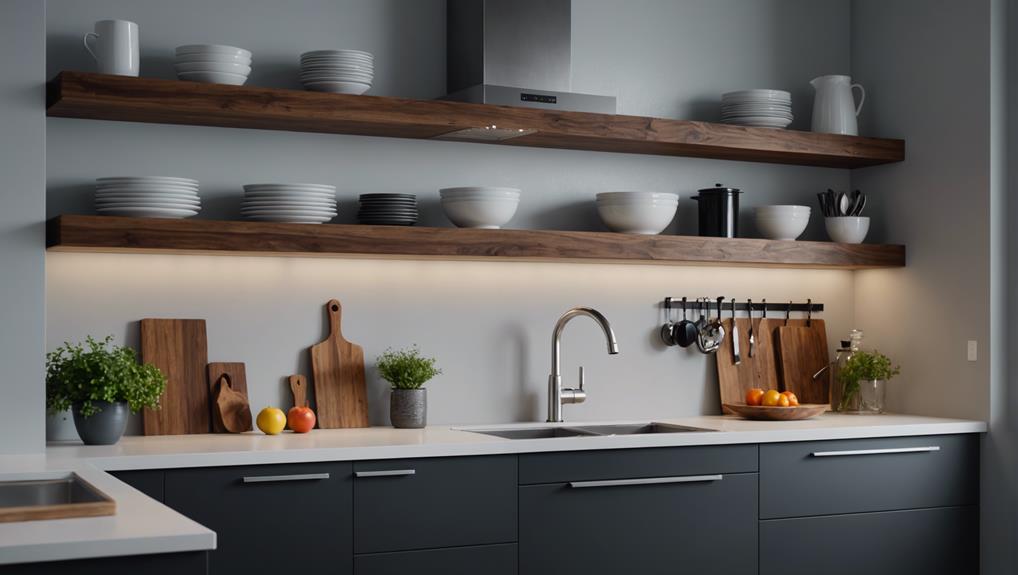
When selecting water-based wood finishes for our floating wood shelves, it's crucial to prioritize options that offer superior durability and protection. These finishes create a strong barrier that resists scratches, ensuring our shelves maintain their pristine look even with regular use. The remarkable durability of water-based finishes allows our shelves to bear heavy objects and frequent handling without compromising their integrity.
In addition to scratch resistance, water-based finishes provide protection against moisture, UV rays, and household chemicals. This comprehensive protection is essential for preserving the natural beauty of the wood, keeping it vibrant and unblemished over time.
The transparent coat formed by these finishes not only enhances the visual appeal of the shelves but also extends their lifespan, making them a wise investment for any modern home design.
Eco-Friendly Benefits
Choosing water-based wood finishes for our floating shelves significantly reduces our carbon footprint due to their lower VOC emissions. This eco-friendly choice drastically decreases indoor air pollution, creating safer and healthier homes. Opting for water-based finishes aligns with sustainable woodworking practices that have minimal environmental impact compared to solvent-based alternatives.
Water-based finishes are non-toxic, ensuring that our living spaces remain free from harmful chemicals. This is especially crucial in enclosed spaces where air quality can quickly deteriorate.
The benefits of choosing eco-friendly water-based finishes include lower VOC emissions, non-toxic properties, support for sustainable practices, and reduced indoor air pollution. These finishes release fewer volatile organic compounds, promoting overall pollution reduction and supporting healthier living conditions.
Furthermore, they contribute to environmentally conscious design choices and responsible resource use, maintaining better air quality inside our homes and enhancing overall well-being.
Color and Sheen Options
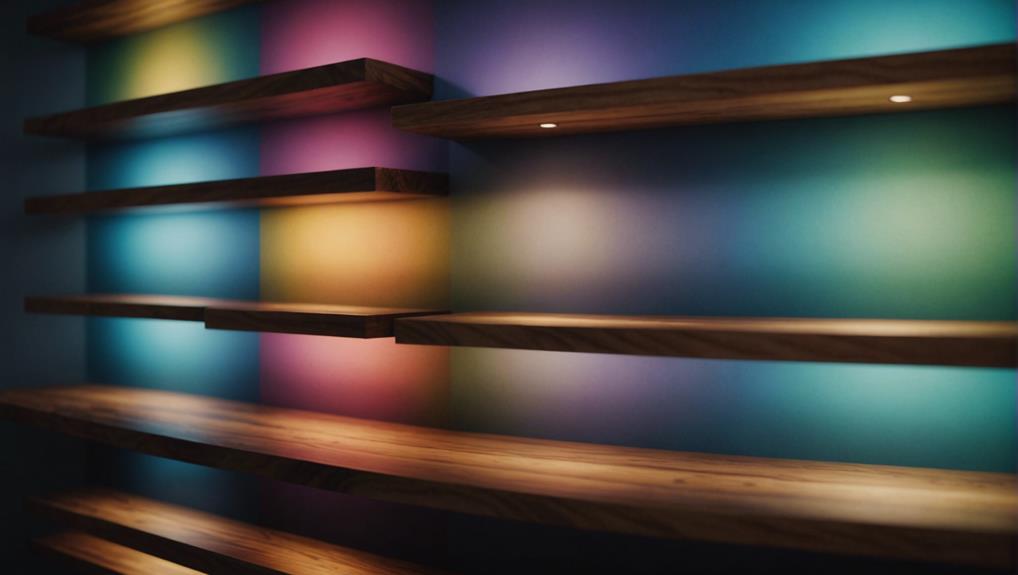
Water-based wood finishes provide a wide range of color and sheen options, allowing us to personalize our floating shelves to complement our decor perfectly. With choices ranging from clear finishes that enhance natural tones to stains like oak, walnut, and mahogany, we can achieve the exact look we desire. The sheen options vary from matte to satin to high gloss, offering us the flexibility to create anything from a subtle, understated appearance to a bold, glossy statement piece.
The appeal of water-based finishes lies in their ability to replicate oil-based finishes, offering deep, rich colors and smooth, glossy sheens without the presence of harmful fumes. By applying multiple coats, we can modify both the color and sheen, resulting in a customizable finish that enhances the innate beauty of our wood shelves. This adaptability is particularly attractive for individuals seeking to incorporate modern and stylish home designs with trendy colors such as gray, black, and white.
Consider the following options to visualize our choices:
| Color Options | Sheen Options | Trendy Colors |
|---|---|---|
| Oak | Matte | Gray |
| Walnut | Satin | Black |
| Mahogany | High Gloss | White |
This guide ensures that our floating wood shelves will be both innovative and tailored to our aesthetic preferences.
Tools You'll Need
For the best results with your floating wood shelf project, you'll need a selection of essential tools. These include brushes, rollers, or spray equipment for applying the wood finish, as well as sandpaper or power sanders for preparing the surface.
Prioritizing safety is crucial, so be sure to wear protective gear such as masks and gloves while working on your project.
Having the right cleanup supplies on hand will ensure a smooth and efficient process from beginning to end.
Essential Application Tools
When applying a water-based wood finish to floating wood shelves, having the right tools is essential for achieving a professional result. Quality tools not only ensure a smooth finish but also make the process more efficient and enjoyable.
To prepare the wood surface, sandpaper and sanding blocks are necessary. Power sanders can be beneficial for larger projects as they speed up the sanding process significantly. Once the surface is smooth, we can proceed to apply the finish.
For a flawless application, high-quality brushes are crucial. Natural bristle brushes are recommended for a smooth and even finish. Depending on the project's size and complexity, we may also consider using rollers and sprayers for application.
Here's a list of essential tools needed:
- Sandpaper and sanding blocks
- Power sanders
- Natural bristle brushes
- Rollers and sprayers
Safety gear is also important to consider. Adequate ventilation is necessary when working with water-based finishes. While not all safety gear requirements will be discussed here, gloves and eye protection are essential.
With these tools at our disposal, we're on track to achieve a stunning, professional finish on our floating wood shelves.
Protective Gear Requirements
When it comes to applying water-based finishes to our floating wood shelves, having the right protective gear is crucial. Safety should always be our top priority during this project.
Let's start with safety goggles. They're essential for protecting our eyes from splashes and fumes that can occur during the application process. Without them, the risk of irritation or serious injury is significantly increased.
Nitrile gloves are another vital piece of protective gear to consider. These gloves create a strong barrier between our skin and the potentially harmful chemicals present in water-based finishes. They're durable and resistant to punctures, ensuring a secure layer of protection for our hands.
Additionally, wearing long-sleeved clothing can help minimize skin exposure and reduce the chances of irritation or allergic reactions.
It's important to work in a well-ventilated area to prevent inhaling fumes. If proper ventilation isn't possible, using a respirator designed for chemical fumes can greatly improve the safety of our breathing environment. Taking proactive measures in this area is crucial for our overall well-being.
Proper disposal of used protective gear, such as gloves, is also essential to prevent environmental contamination.
Cleanup Supplies Needed
Let's gather the essential cleanup supplies to ensure our floating wood shelves look pristine after applying the water-based finish. Effective finish cleanup is crucial for longevity and aesthetic appeal.
For our water-based wood finish, we'll need specific cleaning supplies:
- Water and mild detergent: These are essential for regular maintenance, gently removing dirt or residue without harming the finish.
- Soft cloths or sponges: Ideal for wiping down the shelves after applying the finish to remove any excess product.
- Mineral spirits or denatured alcohol: Perfect for cleaning brushes and tools while the finish is still wet, preventing hardening.
- Warm, soapy water or specialized brush cleaners: Necessary for cleaning dried water-based finishes from brushes and tools, maintaining their usability.
Innovative cleanup methods not only maintain the beauty of our floating wood shelves but also extend the life of our tools. Proper disposal of any leftover finish and used cleaning materials is essential for minimizing environmental impact.
With these supplies on hand, we can ensure a spotless, professional finish every time, keeping our floating wood shelves in excellent condition.
Step-by-Step Guide
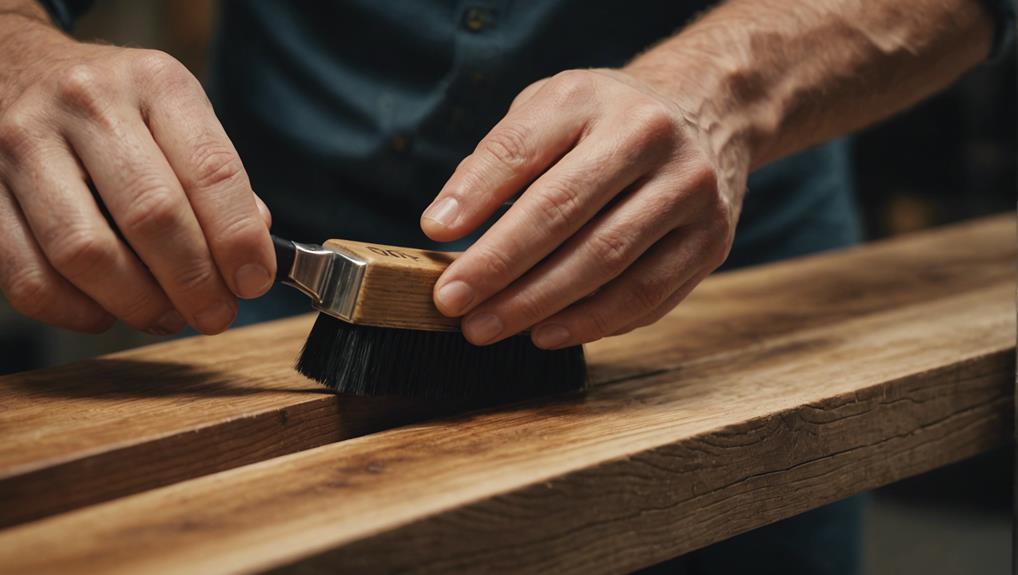
To achieve a professional finish on your floating wood shelves, start by sanding the surfaces until they're smooth. This step is crucial as it ensures the wood finish adheres evenly.
Next, choose a water-based wood finish for its environmentally friendly properties and ease of use. Using a brush or sprayer, apply thin coats, making sure each layer is even and consistent.
Between each coat, allow sufficient drying time as per the manufacturer's instructions. This patience pays off in the long run, creating a durable and flawless surface.
After each coat has dried, lightly sand the surface to maintain smoothness and promote adhesion for the subsequent layers.
Once the base coats are applied, consider adding a top coat. A top coat enhances the shelf's durability, offering extra protection against daily wear and tear, ensuring your shelves not only look great but also stand the test of time.
This final step isn't just about aesthetics; it reinforces the wood's resilience, making your innovative home solutions both stylish and long-lasting.
Maintenance Tips
To keep our floating wood shelves in top condition, it's essential to establish a regular dusting routine using a soft cloth or microfiber duster to prevent dirt buildup.
Additionally, applying a fresh coat of water-based finish periodically will help maintain both the appearance and protection of the shelves.
Regular Dusting Routine
Regular dusting plays a vital role in maintaining the pristine appearance of our floating wood shelves. A consistent dusting routine is essential to prevent the accumulation of dust and grime, which can diminish the overall look of our shelves over time.
By incorporating regular maintenance into our cleaning habits, we can ensure that the wood finish remains vibrant and well-maintained.
To effectively dust our floating wood shelves, it's recommended to utilize gentle tools such as a soft microfiber cloth or a dusting wand. These tools help remove dust without causing any scratches on the surface. Regular dusting on a weekly basis or as needed will help keep our shelves looking clean and shiny.
It's important to avoid using harsh chemicals or abrasive materials as they can potentially harm the wood finish.
When dusting our floating wood shelves, it's crucial to employ gentle techniques to preserve the integrity of the wood finish. By following these simple steps and incorporating regular dusting into our cleaning routine, we can ensure that our shelves maintain their pristine appearance for years to come.
Protective Coating Renewal
To maintain the durability of our floating wood shelves, it's essential to periodically renew the protective coating. Applying a fresh coat of water-based protective coating not only enhances the wood finish but also provides a shield against daily wear and tear. It's recommended to renew the protective coating every 1-2 years to ensure the shelves remain in optimal condition.
Before applying a new coat, lightly sanding the surface is crucial to promote ideal adhesion and achieve a smooth, even finish. Opting for a water-based finish with UV protection is advised for the best results, as it helps prevent discoloration and fading caused by sunlight exposure.
Proper maintenance of the protective coatings on our floating wood shelves can significantly prolong their lifespan, preserving their appearance for years to come.
Here is a simple guide for the renewal process:
- Clean: Wipe down the shelves with a damp cloth to remove any dirt or debris.
- Sand: Lightly sand the surface to prepare it for the new coating.
- Apply Coating: Use a water-based finish with UV protection for long-lasting results.
- Dry: Allow the coating to dry completely before placing items back on the shelves.
Common Mistakes

When it comes to finishing your floating wood shelves, it's crucial to ensure proper surface preparation to achieve good adhesion and durability. Inadequate preparation can result in a lackluster finish that may not withstand daily wear and tear.
Additionally, overworking the finish can be a common pitfall. Water-based finishes tend to set quickly, making it essential to apply them swiftly and evenly for a smooth and professional look.
Environmental factors like temperature and humidity play a significant role in the finishing process. Failure to account for these variables can lead to inconsistent drying times and finish quality. It's important to adjust your application technique based on the conditions to ensure a flawless end result.
Moreover, applying an excessively thick coat of finish can prolong drying times and affect the clarity of the final finish, potentially detracting from the overall visual appeal of your shelves.
Choosing the Right Finish
Now that we've covered common mistakes to avoid, let's delve into selecting the perfect water-based finish for your floating wood shelves.
It's crucial to consider the location and intended use of the shelves to determine the most appropriate wood finish. If the shelves will be exposed to sunlight, it's important to choose a finish with UV protection to prevent color fading and maintain their appearance.
Durability is another key factor to keep in mind. Opt for a high-durability, scratch-resistant finish to ensure your shelves stay looking their best, especially in high-traffic areas or frequently used spaces.
The finish shouldn't only protect against moisture and stains but also enhance the natural beauty of the wood, showcasing its unique grain and texture.
When selecting a finish, it's essential to consider its compatibility with the type of wood used for your shelves. Different wood species react differently to various finishes, so make sure the finish you choose complements the specific wood type you're working with, whether it's oak, maple, or a more exotic species.
The right water-based finish can truly make a difference in the overall look and longevity of your floating wood shelves.
Frequently Asked Questions
How to Finish Wood Floating Shelves?
To finish wood floating shelves, the first step is to carefully sand the surface using precise techniques to ensure a smooth and even finish. This helps to prepare the wood for the next steps in the finishing process.
After sanding, it's time to explore innovative stain choices to enhance the natural beauty of the wood. By selecting unique and high-quality stains, you can achieve a desired aesthetic for your floating shelves. Consider using stains that bring out the grain and color of the wood for a stunning final result.
When applying the stain, it's important to use efficient methods to ensure an even and consistent coverage. Following the manufacturer's recommendations for drying times is crucial to allow the stain to fully penetrate and set, resulting in a durable finish on your shelves.
For long-lasting results, incorporating proactive maintenance tips is key to keeping your floating shelves looking pristine. Regular dusting and cleaning, as well as avoiding excessive moisture or direct sunlight, can help preserve the finish and extend the life of your shelves.
What Is the Best Finish for Wood Shelves?
The ideal finish for wood shelves strikes a perfect balance between creativity and functionality. Leading brands such as Minwax and Varathane offer innovative options that, when combined with proper surface preparation and fast drying times, deliver stunning and long-lasting results suitable for indoor use.
When it comes to floating wood shelf materials, the choice of finish plays a crucial role in both aesthetics and durability. Opting for high-quality finishes from reputable brands ensures that your wood shelves not only look beautiful but also withstand the test of time. By utilizing the right tools and techniques, you can achieve a flawless finish that enhances the natural beauty of the wood while providing protection against wear and tear.
Wood finish options for floating shelves are vast, ranging from traditional stains to modern polyurethanes. Each type of finish offers unique benefits in terms of appearance and performance. Stains can enhance the natural grain of the wood, while polyurethanes provide a tough protective layer that resists scratches and moisture. By considering the specific requirements of your project, you can select a finish that meets your needs and enhances the overall look of your wood shelves.
What Is the Best Water Resistant Finish for Wood?
Let's dive into the top water-resistant finishes for wood when considering materials for floating wood shelves. Polyurethane coating, varnish application, epoxy resin, marine varnish, and lacquer finish all offer distinct advantages when it comes to protecting wood. However, for floating wood shelves, the best option would be epoxy resin due to its exceptional durability and resistance to moisture, making it ideal for high-traffic areas in homes or commercial spaces.
When it comes to floating wood shelves, the choice of wood finish is crucial in ensuring longevity and resilience against water damage. Epoxy resin stands out as a top choice for its ability to provide a strong protective barrier that seals and shields the wood from moisture, preventing warping or decay. This makes it an excellent option for floating wood shelves in bathrooms, kitchens, or any other areas where exposure to water is a concern.
In comparison to other water-resistant finishes like polyurethane or varnish, epoxy resin offers superior durability and long-lasting protection. Its seamless application creates a smooth and impermeable surface that not only enhances the aesthetic appeal of the wood but also ensures its longevity in challenging environments. For floating wood shelves that need to withstand daily use and potential water exposure, epoxy resin is the optimal choice for maintaining their integrity and beauty over time.
Considering the unique requirements of floating wood shelves, such as the need for water resistance and durability, epoxy resin emerges as the most reliable option for ensuring the longevity and quality of the shelves. By choosing epoxy resin as the wood finish for floating shelves, you can enjoy both protection against water damage and a visually appealing finish that enhances the overall look of your space.
What Is a Water-Based Wood Finish?
A water-based wood finish is an environmentally friendly coating that offers a range of gloss levels. It is easy to apply, dries quickly, and comes with safety features that make it a great choice for floating wood shelf projects. Its sustainable benefits make it ideal for those looking for a durable and eco-conscious finish option.
When considering wood finish options for floating wood shelves, water-based finishes stand out for their low toxicity and minimal environmental impact. These finishes are made up of water, resins, and other natural ingredients, making them a safer choice for indoor use. Additionally, water-based wood finishes are known for their quick drying time, allowing for faster project completion compared to oil-based finishes.
Innovative projects that prioritize sustainability and safety can greatly benefit from using water-based wood finishes. These finishes not only provide a protective coating for wood surfaces but also contribute to a healthier indoor environment by emitting fewer harmful chemicals. With their ease of application and eco-friendly properties, water-based wood finishes are a smart choice for those looking to create stylish and environmentally conscious floating wood shelves.
Conclusion
We've delved into the realm of water-based finishes for floating wood shelves, covering everything from the different types available to the necessary preparation, application, and maintenance steps.
Were you aware that opting for water-based finishes can lead to a significant reduction in VOC emissions by up to 90%, making them a truly eco-conscious choice? Let's embrace these sustainable alternatives to safeguard our shelves and the environment simultaneously.
By adhering to our comprehensive guide, you can achieve a resilient and visually appealing finish that will endure the test of time, ensuring your shelves retain their pristine appearance for many years to come.

